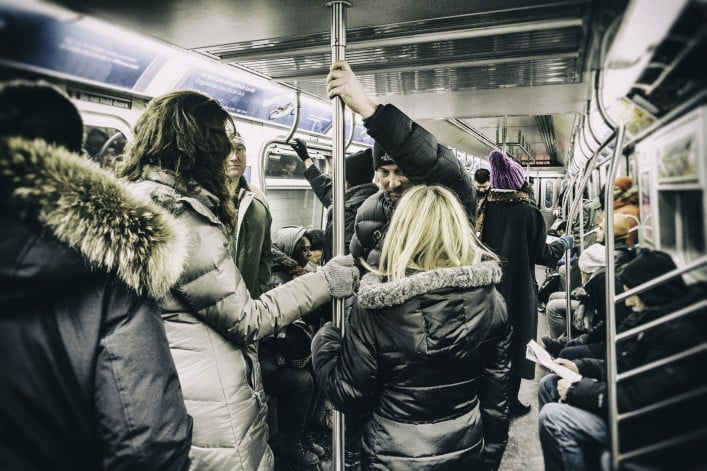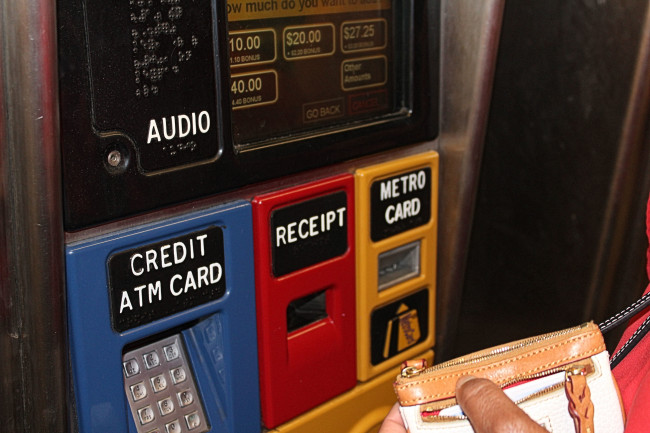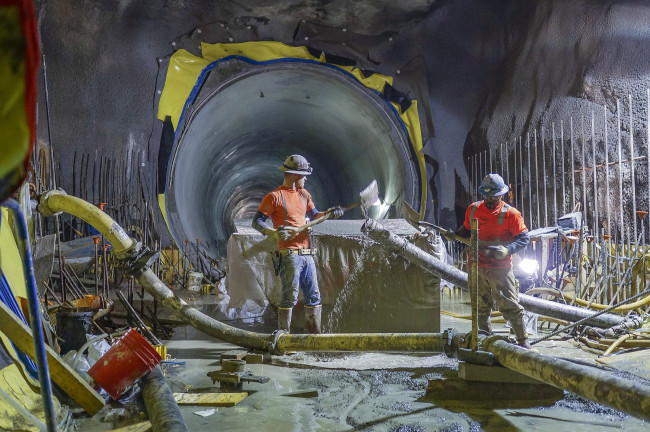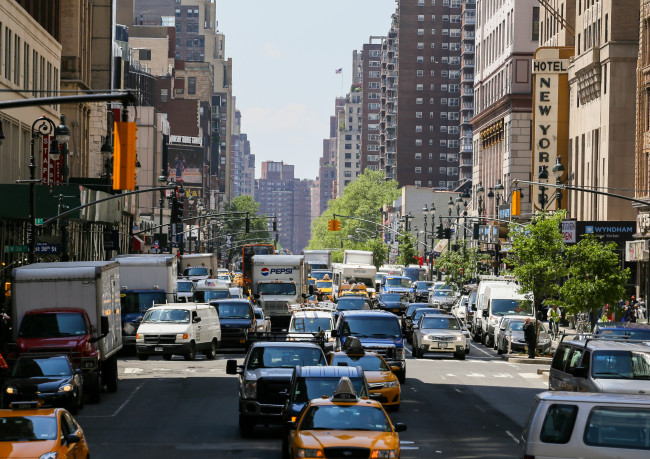What it’s like to navigate NYC when you have a disability
It’s been 26 years since the passage of the Americans with Disabilities Act (ADA), a piece of civil rights legislation intended to ensure that people with disabilities are protected from discrimination and enjoy the same rights and opportunities as everyone else. Among the ADA’s provisions is the guarantee of accommodations for people with disabilities, which has led to the transformation of many public spaces into more accessible areas.
But New York City has lagged behind significantly when it comes to making its transit, streets, and sidewalks into spaces that can be easily traversed. As an article in the Huffington Post notes, less than 20 percent of NYC’s 468 subway stations have elevators that allow people with ambulatory disabilities to access trains.
According to the Center for Independence of the Disabled, New York (CIDNY), there are 889,219 people with physical or cognitive disabilities currently residing in the city. The MTA's list of accessible stations reveals that Manhattan has the most--51--while the Bronx has the fewest, a mere 13 ADA-compliant subway stops. Last year, lawyer Matthew Ahn created a map of what the subway system looks like to someone with an ambulatory disability, revealing that huge swaths of the city are unreachable by train, including much of the Upper East Side, Greenwich Village, and Harlem. Furthermore, there are no accessible stations between Long Island City and Woodside in Queens, or in most of South Brooklyn and the South Bronx.
Rebecca Rodgers, a staff attorney with Disability Rights Advocates, explains that under ADA regulations, the city is required to make 100 stations accessible by 2020; plus, when it alters existing stations, it must make those accessible as well. Despite this, the DRA has had to bring lawsuits against the MTA to ensure it fulfills these obligations. When Inwood’s Dyckman Street station was renovated, for instance, DRA lawyers sued in order to have an elevator installed.
“We understand old facilities cost money to update, but access to transportation is a civil right,” Rodgers says. “Twenty-six years after the ADA, there is simply no excuse.”
That said, elevator outages are frequent even at the stations that do have them, and while alternatives to the subway—like accessible buses and the city’s Access-A-Ride service—are technically available, these options can pose their own set of complications.
The frustrations of relying on public transit
Monica Bartley, community outreach specialist with CIDNY, uses a wheelchair, and describes the frustrations that come with trying to navigate the city. The subway, she says, is definitely the quickest option, provided that she’s traveling between stations with working elevators.
But once Bartley is ready to exit the train, hazards emerge: “When I get to my stop, it doesn’t mean the train will line up with the platform for me to get off. Usually, passengers have to help pull my chair off, because there's that wide gap,” she explains. “Passengers come to the rescue, but the chair is very heavy to move.”
And when Bartley makes it out of the station, she may have to travel a long way until she finds a curb cut that allows her to cross the street. “I face a number of barriers just trying to travel in the city,” she says.
Rodgers agrees that a lack of curb cuts is a major obstacle. “People are often faced with the choice of going all around to find a curb cut or just going into the street. At best it's incredibly inconvenient and a huge waste of time, at worst it’s a major safety concern,” she says.
She adds that ramps are particularly scarce in lower Manhattan, and overall accessibility is poor in the outer boroughs: “There is more accessibility in Midtown, but everyone matters, and there are big parts of the city that are much less convenient to travel to.”
City buses are all accessible, technically speaking, but Bartley says that is no guarantee that New Yorkers with disabilities will be able to board. “The problem you encounter is that some drivers do not want to pick up a wheelchair passenger, or they stop far from the curb and you can’t board the bus in the middle of the road. Other times there are two wheelchair passengers already there, which means you can’t get on,” Bartley explains. “Sometimes you feel as if you are discriminated against. You don’t feel equal with other citizens.”
A third option for New Yorkers with disabilities, Access-A-Ride, allows them to request a ride in advance to any destination in the city covered by public transit. Bartley says that using this service entails building in lots of extra time—sometimes hours—to get from one place to another. “Most times, it’s not on time,” she says. “You have to learn how to readjust your life to cope with that loss of time.
As for which parts of the city are the most or least difficult to navigate, based on accessbility, Bartley says, "It's pretty much challenging across the board. There are consistent problems, and elevators don't work across the board."
Melissa Veale, who works at the VA Rehabilitation, Research & Development National Center, and also uses a wheelchair, says that she now drives and hasn’t used public transportation in years. “My decision to learn how to drive was really so I can come and go as I please,” she says. “I depended on Access-A-Ride (known in the handicapped community as Stress-A-Ride) to take me to and from work, but it was hell at times waiting forever for them to get me.”
What NYC could do to improve accessibility
The advanced age of New York’s public transportation infrastructure certainly poses unique challenges to bringing it into the modern world. As The Guardian explains, the century-old subway has many maintenance needs, its signaling system being one urgent priority.
Other urban centers, like Washington, D.C. and Chicago, have newer systems, and rate much better when it comes to transit accessibility. But NYC could still examine these cities’ approaches for inspiration.
Rebecca Rodgers notes that while D.C. isn’t perfect—its Metro has its own issues, as the Washington Post lays out—there are still elevators at 100 percent of stations.
Chicago also has a high percentage of accessible stations, Rodgers says, as well as a plan underway to significantly improve access. According to Medill Reports, 70 percent of the Windy City’s stations have ADA-compliant elevators or ramps, and over the next 20 years, the entire system will be made navigable to people with disabilities.
Given that other large cities have made accessibility a priority, disability advocates in New York say they don’t know why NYC hasn’t done the same. Margi Trapani, director of communications and education at CIDNY, says, “It’s very hard for all of us to understand why the city hasn’t placed more emphasis on making accessible transportation.”
She points out that New York’s infrastructure poses challenges not only to locals, but also to tourists who have disabilities. “We get calls from families who want to know if places are accessible and how they’re going to travel, and it’s very disheartening for them,” Trapani says.
Manhattan borough president Gale Brewer has advocated for improvements; per NPR, her office released a report last year that found that less than 10 percent of curb cuts along Broadway are accessible, and urged for more frequent inspections and greater compliance with the ADA. And Public Advocate Letitia James collaborated with CIDNY on a study of NYC’s polling sites, finding that a large percentage had barriers to accessibility.
But there needs to be more action on the issue, Trapani says: “It’s been over 26 years now that the ADA has been alive. The city has had a long time to reassess the needs, and still we're dealing with the same problem. Part of it is making a priority out of accessibility, and part of it is recalcitrance.”
You Might Also Like





























